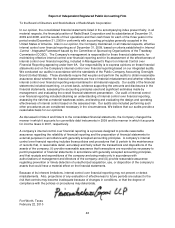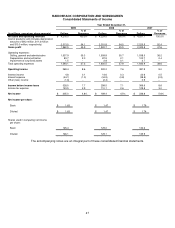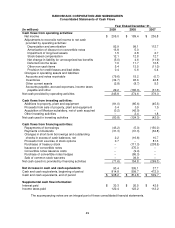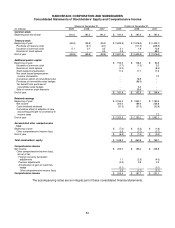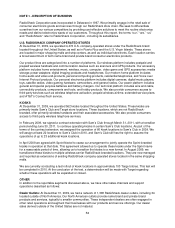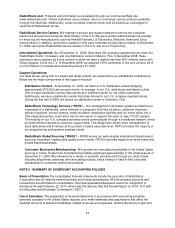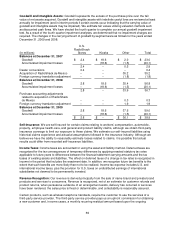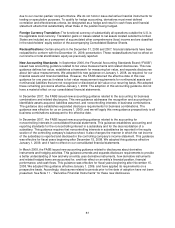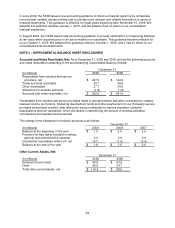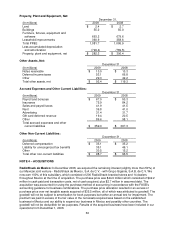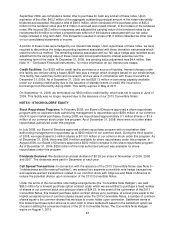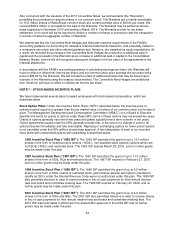Radio Shack 2009 Annual Report Download - page 63
Download and view the complete annual report
Please find page 63 of the 2009 Radio Shack annual report below. You can navigate through the pages in the report by either clicking on the pages listed below, or by using the keyword search tool below to find specific information within the annual report.56
arrangement between the service provider and the customer. Our sale of an activated wireless telephone
handset is the single event required to meet the delivery criterion for both the upfront commission and the
residual revenue. Upfront commission revenue, net of estimated service deactivations, is generally
recognized at the time an activated wireless telephone handset is sold to the customer at the point-of-
sale. Based on our extensive history in selling activated wireless telephone handsets, we have been able
to establish reliable deactivation estimates. Recurring residual income is recognized as earned under the
terms of our contracts with the service providers, which is typically as the service provider bills its
customer, generally on a monthly basis. Sales of wireless handsets and the related commissions and
residual income constitute more than one-third of our total revenue. Our three largest third-party wireless
service providers are Sprint Nextel, AT&T, and T-Mobile.
Cost of Products Sold: Cost of products sold primarily includes the total cost of merchandise inventory
sold, direct costs relating to merchandise acquisition and distribution (including depreciation and excise
taxes), costs of services provided, in-bound freight expenses to our distribution centers, out-bound freight
expenses to our retail outlets, physical inventory valuation adjustments and losses, customer shipping
and handling charges, and certain vendor allowances (see “Vendor Allowances” below).
Vendor Allowances: We receive allowances from third-party service providers and product vendors
through a variety of promotional programs and arrangements as a result of purchasing and promoting
their products and services in the normal course of business. We consider vendor allowances received to
be a reduction in the price of a vendor's products or services and record them as a component of
inventory until the product is sold, at which point we record them as a component of cost of products sold
unless the allowances represent reimbursement of specific, incremental and identifiable costs incurred to
promote a vendor's products and services. In this case, we record the vendor reimbursement when
earned as an offset to the associated expense incurred to promote the applicable products and/or
services.
Advertising Costs: Our advertising costs are expensed the first time the advertising takes place. We
receive allowances from certain third-party service providers and product vendors that we record when
earned as an offset to advertising expense incurred to promote the applicable products and/or services
only if the allowances represent reimbursement of specific, incremental and identifiable costs (see
“Vendor Allowances” above). Advertising expense was $193.0 million, $214.5 million and $208.8 million
for the years ended December 31, 2009, 2008 and 2007, respectively.
Stock-Based Compensation: We measure all employee stock-based compensation awards using a fair
value method and record this expense in the consolidated financial statements. Our stock-based
compensation relates to stock options, restricted stock awards, and other equity-based awards issued to
our employees and directors. On the date that an award is granted, we determine the fair value of the
award and recognize the compensation expense over the requisite service period, which typically is the
period over which the award vests.
Fair Value Measurements: Certain assets and liabilities are required to be measured at fair value either on
a recurring basis or non-recurring basis. We estimate fair values based on one or more of the following
valuation techniques: the market approach (comparable market prices), the income approach (present value
of future income or cash flow), or the cost approach (cost to replace the service capacity of an asset or
replacement cost). See Note 12 - “Fair Value Measurements” for additional disclosures of our fair value
measurements.
Derivative Instruments and Hedging Activities: We recognize all derivative financial instruments in the
consolidated financial statements at fair value. Changes in the fair value of derivative financial
instruments that qualify for hedge accounting are recorded in stockholders’ equity as a component of
comprehensive income or as an adjustment to the carrying value of the hedged item. Changes in fair
values of derivatives not qualifying for hedge accounting are reported in earnings.
We maintain internal controls over our hedging activities, which include policies and procedures for risk
assessment and the approval, reporting and monitoring of all derivative financial instrument activities. We
monitor our hedging positions and creditworthiness of our counter-parties and do not anticipate losses


